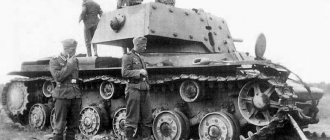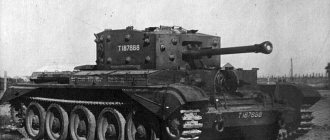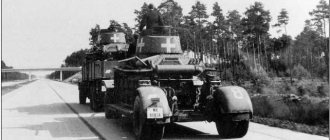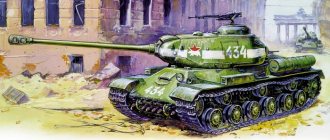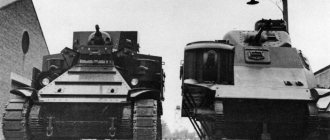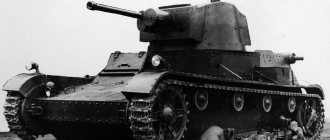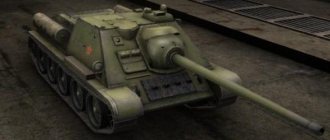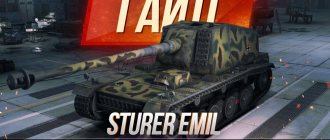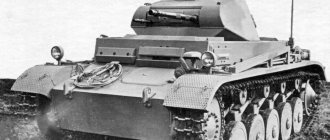76 mm F-34 tank gun
Author: Valery Potapov
First published 09.22.2005 00:06
Last edition 09/27/2011 18:06
The material was read by 36572 people
<< Prev. page — Page 2 of 2 — Next. page
The F-34 turned out to be not only powerful, but also cheap and high-tech. The cost of the F-34 turned out to be 20% lower than the F-32 (previously mounted in the KV-1 tank), which was reflected in the volume of their production. All the stories that, due to the disadvantage of the F-34, F-32 guns and even 45-mm cannons were installed on the T-34, need to be read exactly the opposite. The F-34 became the only tank gun that was produced in the required quantity in 1941 (its production was carried out by factories No. 92 and No. 13, and later No. 9), and it was just the F-32 that was in short supply (produced with difficulty by the Kirov plant). There is evidence that in October 1941, a battery of F-34 guns on field mounted machines from the F-22USV , since there was a catastrophic shortage of divisional guns. From the moment of its birth, the F-34 was a competitor to the F-32 cannon in the armament of the KV tank. According to the order of Deputy People's Commissar of Defense G. Kulik dated February 18, 1941, the F-34 gun at plant No. 92 was installed in the turret of the KV-1 tank, and the tests took place in February-March 1941 and gave a positive result. But in the spring of 1941, a gun with the ballistics of a 76-mm anti-aircraft gun (ZIS-5) was already expected for the KV, and arming it with the F-34 gun was considered unpromising. However, on September 22, 1941, due to difficulties with the production of F-32 guns at the Kirov Plant, the NKTP issued order No. 26ss, ordering ChTZ to urgently develop an option for installing the F-34 gun in the KV-1 tank, and for Uralmashzavod to provide supplies for it armored masks. By the end of September, 40 F-34 guns converted in this way were shipped to the customer. And from October 1, the ZIS-5 tank gun was adopted for service with the KV tank, basically repeating the design of the F-34.
With the start of mass production of the ZIS-5, the design of the F-34 was changed to simplify serial production. Thus, since November 1941, the F-34 gun received the following changes: - the two-layer barrel was replaced with a monoblock one; — a shutter was introduced, unified with the shutter of the ZIS-2 , ZIS-Z and ZIS-5; — the semi-automatic mechanism has been simplified; — the fastening of the coupling in the cradle has been changed.
As a result of these changes, the cost of the F-34 decreased by another 7-10%.
TACTICAL AND TECHNICAL CHARACTERISTICS
| Parameter | Meaning |
| Caliber, mm | 76,2 |
| Barrel length, club. | 41,6 |
| Mass of the swinging part, kg | 1155 |
| Weight of sliding parts, kg | 538 |
| Length is normal. rollback, m | 0,32-0,37 |
| Length max. rollback, m | 0,39 |
| Loading | unitary |
| Ballistics | 76 mm divisional gun |
| Rate of fire in min. | 4-8* |
The practical rate of fire in the T-34 tank was 3-5 rounds per minute due to poor placement of ammunition.
TABLE OF ARMOR PENETRATION*
| Ammunition | Corner | Distance, m | ||||
| 100 | 300 | 500 | 1,000 | 1,500 | ||
| BR-350A | 60° | NP=86 GP=69 | NP=79 GP=63 | NP=70 GP=59 | NP=63 GP=50 | NP=52 GP=43 |
| 90° | NP=89 GP=80 | NP=84 GP=76 | NP=78 GP=70 | NP=73 GP=63 | NP=65 GP=58 | |
| BR-350B | 60° | NP=89 GP=74 | NP=82 GP=69 | NP=76 GP=62 | NP=71 GP=55 | NP=55 GP=48 |
| 90° | NP=94 GP=86 | NP=90 GP=81 | NP=84 GP=75 | NP=78 GP=68 | NP=69 GP=62 | |
| BR-350P | 60° | GP=92 | GP=87 | GP=77 | No | No |
| 90° | GP=102 | GP=98 | GP=92 | No | No | |
*Initial penetration (IP) means that 20% of the projectile fragments ended up behind the penetrated armor plate. Guaranteed penetration (GP) means that 80% of the projectile fragments ended up behind the penetrated armor plate.
Beginning speed - 680 m/s AMMUNITION FOR 76.2 MM F-34, ZIS-5 AND S-54 GUNS
| SHOT | PROJECTILE | CHARGE | ||||||
| Index | Weight, kg | Index | Weight, kg | Length, club | Explosive mass, g | Fuse | Index | Weight, kg |
| Fragmentation, high explosive | ||||||||
| UOF-354M | 8.82 | OF-350 | 6.2 | 4 | 0.71 | KTM-1, KTM-3 | 54-G-354 | 1.08 |
| UOF-354B | 8.82 | OF-350B | 6.2 | 4 | 0.64 | KTM-1, KTM-3, MG-N, KTMZ1-U | G-354 | 0.86 |
| UO-354AM | 8.83 | O-350A | 6.21 | 4 | 0.54 | KTM-1 | 54-G-354 | 1.08 |
| UV-354 | 8.52 | F-350 | 6.41 | 4 | 0.785 | KT3, KTM-3, 3GT | G-354A | 0.9 |
| UV-354M | 8.52 | F-350M | 6.1 | 4 | 0.815 | KTM-3 | G-354A | 0.9 |
| UV-354F | 8.85 | F-350F | 6.41 | 4 | 0.785 | AD, AD-2, ADM | G-354A | 0.9 |
| ARMORS-PIECING CALIBER | ||||||||
| UBR-354A | 9.12 | BR-350A | 6.3 | 4.2 | 0.15 (TNT) | MD-5 | 54-G-354 | 1.08 |
| UBR-354B | 9.1 | BR-350B | 6.3 | 4.2 | 0.155 (TNT) | MD-8 | 54-G-354 | 1.08 |
| UBR-354SP | 9.2 | BR-350SP | 6.6 | 2.3 | No | No | 54-G-354 | 1.08 |
| ARMORS-PIECING SUB-CALIBER | ||||||||
| UBR-354P | 6.3 | BR-350P | 3.02 | 2.4 | No | No | 54-G-354P | 1.08 |
| UBR-354N* | 6 | BR-350N* | 3.02 | 2.4 | No | No | 54-G-354N | 1.4 |
| ARMOR BURNING | ||||||||
| No | ||||||||
| BAPPOINT AND SHRAPNEL | ||||||||
| USH-354 | 8.94 | Shch-354 | 6.5 | 3 | 0.085 | 22 sec., D | 54-G-354A | 0.9 |
| USH-354T | 9.1 | Shch-354T | 6.66 | 3 | 0.085 | T-6 | 54-G-354A | 0.9 |
| UShch-354G | 9.02 | Shch-354G (Harts) | 6.58 | 3.9 | 0.085 | 22PG | 54-G-354A | 0.9 |
| Incendiary | ||||||||
| UZ-354 | 8.86 | Z-35O** | 6.24 | 3.3 | 0.24 | T-6 | 54-G-354 | 1.08 |
| UZ-354S | 8.86 | Z-350С | 4.65 | 3 | 0.24 | 22 sec | 54-G-354A | 1.08 |
| SMOKE | ||||||||
| UD-350 | 9.12 | D-350** | 6.45 | 4 | — | KTM-2 | 54-G-354 | 1.08 |
| UD-354A | 9.12 | D-350A | 6.45 | 4 | — | KTM-1 | 54-G-354 | 1.08 |
* Developed after the war; ** Long range.
Sources: A. Shirokorad “Encyclopedia of Domestic Artillery”, 2000 Encyclopedia of weapons of Kosmet “Artillery weapons of Soviet tanks 1940-1945” Armada-Vertical, No. 4, 1999
“FirstPrev. page 2 Next pageLast»
Rate this material: 110
(13 votes, average 4.23 out of 5)
Comments
0 Fatmax2003 04/21/2015 20:35 What, by the way, is said here on the site, you just have to follow the “ZiS-5” link...
0 Fatmax2003 04/21/2015 20:28 When the F-34 was installed on the KV-1, then it was called the ZiS-5. The differences are minor - axles, a cradle, something else is the same, but this is no longer an F-34.
The differences are minor - axles, a cradle, something else is the same, but this is no longer an F-34. Therefore, everything is correct - the F-34 was installed only on the T-34.
Therefore, everything is correct - the F-34 was installed only on the T-34.
-1 agof 05/20/2012 14:36 Well, these are not “serial” tanks, these are “experimental tanks”. In addition, the article itself says that they were installed in a small series on the KV-1.
+1 Valery Potapov 05/11/2012 09:02 No error. There was some planning, but in fact the gun was only installed on the T-34 in mass production. And so... well, there were even plans to put it on the Lend-Lease Matilda.
-1 agof 05/10/2012 19:18 In the application it is written that it was used only on the T-34-76. /kv1/stranitsa-2-boevoe-primenenie.html It is indicated here that it was planned to be installed on the KV-1, in addition there are photographs of the KV-1 with the F-34 installed
Update list of comments
Please register to be able to post comments.
New in blogs
F-34 in the T-34 tank.
The 76-mm F-34 tank gun is a tank gun from Gorky Plant No. 92, which was serially equipped with T-34 tanks starting in 1941.
Developed on the initiative of the design bureau of Gorky Plant No. 92 by a group of leading designer P.F. Muravyov, under the general leadership of V.G. Grabin.
https://forum.worldoftanks.ru/index.php?/topic/73128-%D0%B8%D1%81%D0%BF%D1%8B%D1%82%D0%B0%D0%BD%D0% B8%D1%8F-%D0%BF%D1%83%D1%88%D0%BA%D0%B8-%D1%84-32-%D0%B8-%D0%BB-11-%D0% BD%D0%B0-%D1%82%D0%B0%D0%BD%D0%BA%D0%B0%D1%85-%D0%B1%D1%82-7-%D0%B8-%D1 %82-28/
at this address is a very detailed comparative report on tests of the L-11 and F-32 guns (predecessor of the F-34).
Grabin himself mentions that the F-32 was, at the request of the customer and against the will of the designers, noticeably shortened with a noticeable loss of combat qualities for the sake of the fear that existed then that the tank could cling to the ground with its gun barrel. This did not allow the F-32 to realize all the capabilities originally built into its design. The design of the gun was completed on March 15, 1939, the first tests of the gun mounted on the T-28 tank took place on October 19, 1939 at the Gorokhovets training ground. However, it was decided to abandon the rearmament of the T-28 and T-35 tanks, and the gun was reassigned to the new T-34 tank, on which the first firing from the F-34 cannon was carried out in November 1940.
I note that until March 41, a little more than 400 T-34s with L-11 (L-30 cal.) were produced, and subsequently they began to install F-32-34. (L-40.5 cal.)
On November 21-23, 1940, the T-34 tank with an installed gun underwent intensive testing at the Gorokhovets training ground of the Moscow Military District (2807 rounds were fired over three days). A commission consisting of the chief designer of Plant No. 92, Major General V. G. Grabin, the head of the artillery department of the VAMM, military engineer 1st rank N. S. Ogurtsov, a representative of the 14th Tank Division, Lieutenant Amelin, and the designer of Plant No. 92 P. F. Muravyova, based on the results of ground-military tests, concluded that “the 76-mm F-34 tank gun is a completely modern gun for the T-34” and in conclusion proposed recommending the F-34 tank gun for armament with the T-34 tank.
After changes were made to the design, in July 1941 the gun was adopted by the Red Army under the official name 76-mm tank gun mod. 1940
Serial production of the F-34 was carried out at plant No. 92, according to some sources, from 1940 to 1944, and according to others, from February 1941 to 1944. A total of 38,580 guns were manufactured.
The KV had a modification of the F-34 called the ZiS-5.
The F-34 cannon was installed on T-34 tanks, armored boats (projects 1124, II series, 1125, II series and S-40) and armored trains, becoming one of the most popular Soviet weapons during the war. At the beginning of 1941, the F-34 had no analogues among foreign serial tank guns in terms of power. The ballistic characteristics of the gun (coinciding with the ballistics of 76-mm divisional guns with a barrel length of 40 calibers - USV, ZIS-3) until the end of 1942 made it possible to successfully fight German armored vehicles; however, the appearance in 1943 of the Tiger and Panther tanks, as well as a significant increase in the frontal armor of the Pz.III, Pz.IV tanks and StuG III assault guns, significantly reduced the effectiveness of the gun.
1. UBR-354A round with BR-350A projectile (Blunt-headed with a ballistic tip, tracer). 2. UBR-354B shot with a BR-350B projectile (Blunt-headed with a ballistic tip, with localizers, tracer). 3. UBR-354P shot with a BR-350P projectile (Sub-caliber armor-piercing projectile, tracer, “coil” type). 4. UOF-354M shot with an OF-350 projectile (Steel high-explosive fragmentation projectile). 5. USh-354T shot with Sh-354T projectile (Shrapnel with T-6 tube)
Of course, the data on armor penetration is very different for different shells. Nevertheless, for a sabot at a distance of 500m the maximum is given. penetration is 92mm (at an angle of 90 degrees) and 77mm at an angle of 60 degrees.
For the slow-witted, the numbers are noticeably smaller - at a distance of 1500m no more than 65 mm is given at a meeting angle of 90 degrees.
And as far as I remember, all these shells did not penetrate the frontal and turret armor of the T-6 Tiger at all, even when fired at point blank range of 200m. They simply collapsed, which caused the production of shells with localizers (increased armor penetration.) This is according to Baryatinsky (Hitler’s Tanks in battle). But let’s say the Englishman Roger Ford writes that the F-34 shells did not penetrate the Tiger’s armor at a distance of more than 400m (does it mean that they did at a distance less than that?)
I somehow believe Baryatinsky more, because he refers to the results of shelling of the Tiger corps at the Kubinka training ground in the spring of 43 from various artillery systems.
Localizer - sharp grooves are made on the outer surface of some armor-piercing projectiles, the so-called. localizer cuts. When penetrating thick armor, localizer undercuts preserve the projectile body when its head part is destroyed and protect the explosive chamber from opening at the moment of impact on the armor. In sharp undercuts, stresses in the metal are concentrated, so upon impact, metal chipping occurs along the undercuts, and cracks do not propagate deep into the body.
Links[edit]
- ^ a b c amvas. "Guns and ammunition of Soviet tanks". www.armchairgeneral.com
. Retrieved September 17, 2022. - Collateral, Steve (1984). Soviet tanks and combat vehicles from World War II. Grandsen, James. London: Arms and Armor Press. paragraph 225. ISBN 0853686068. OCLC 12810882.
- Zaloga, Stephen J.; James Grandsen (1984). Soviet tanks and military equipment from World War II
. London: Arms and Armor Press. ISBN 0-85368-606-8.
Firepower
Firepower
Early T-34 tanks were equipped with a 76-mm cannon mod. 1938/39 L-11 with a barrel length of 30.5 calibers and an initial armor-piercing projectile speed of 612 m/s. Vertical aiming – from –5° to +25°. Practical rate of fire in a tank is 1-2 rounds/min. The gun had a vertical wedge semi-automatic breech with a device for disabling semi-automatic action, since in the pre-war years the GABTU leadership believed that there should not be semi-automatic equipment in tank guns (due to gas contamination in the fighting compartment). A special feature of the L-11 gun was its original recoil devices, in which the fluid in the recoil brake was in direct contact with atmospheric air through a small hole. The main drawback of this weapon was also associated with this circumstance: if it was necessary to alternately fire quickly at different angles of elevation of the barrel (which was not uncommon in a tank), the hole was blocked, and the liquid boiled when fired, bursting the brake cylinder. In order to eliminate this drawback, a reserve hole with a valve was made in the L-11 recoil brake for communication with air when firing at a declination angle. The L-11 gun, in addition, was very complex and expensive to produce. It required a wide range of alloy steels and non-ferrous metals; the manufacture of most parts required milling work of high precision and cleanliness.
L-11 gun:
1– trunk; 2 – mask installation; 3 – axle; 4 – gun travel position stopper; 5 – gear sector of the lifting mechanism; 6 – sight forehead; 7 – pillow; 8 – sleeve catcher; 9 – DT machine gun
A relatively small number of T-34 tanks were produced with the L-11 cannon - according to various sources, from 452 to 458. In addition, they armed several vehicles during repairs in besieged Leningrad and 11 tanks in Nizhny Tagil in January 1942. For the latter, guns from those taken from Kharkov during the evacuation were used. Since the L-11 gun did not become a massive tank gun of the Great Patriotic War, and the T-34 tanks on which it was installed were mostly lost in its first month, there is no point in dwelling in detail on its combat characteristics. So let’s immediately move on to the most popular (about 37 thousand guns were produced) domestic tank gun F-34.
76 mm gun mod. 1940 F-34 with a barrel length of 41.5 calibers was installed on the T-34 from March 1941. Gun weight 1155 kg. The maximum rollback length is 390 mm, vertical guidance from –5°30′ to +26°48′. The shutter is wedge, with semi-automatic mechanical copy type. The gun's recoil devices consisted of a hydraulic recoil brake and a knurler and were located under the barrel. The cannon was fired using foot and manual mechanical triggers.
The F-34 gun has been modernized twice. During the first improvement, the bolt and semi-automatic mechanism with a copying device, trigger mechanisms were changed, the compensator in the recoil brake, the safety lock for locking the bolt in a traveling manner, and the bracket with the buffer were eliminated. In the second case, instead of a barrel with a free pipe, a monoblock barrel with a breech was installed, connected to the pipe using a coupling.
082 Serial T-34 tank, armed with the L-11 cannon. August 1940
For firing from the L-11 and F-34 guns, unitary cartridges from divisional guns mod. 1902/30 and arr. 1939 and from the regimental gun mod. 1927:
– with a high-explosive long-range fragmentation grenade (steel OF-350 and steel cast iron OF-350A) and a KTM-1 fuse;
– with an old Russian-style high-explosive grenade (F-354) and KT-3, KTM-3 or 3GT fuses;
– with an armor-piercing tracer projectile (BR-350A, BR-350B, R-350SP) and an MD-5 fuse;
– with an armor-burning projectile (BP-353A) and a BM fuse;
– with bullet shrapnel (Sh-354 and Sh-354T) and Hartz shrapnel (Sh-354G), with tubes – 22-second or T-6;
– with rod shrapnel (Sh-361) and T-3UG tube;
– with buckshot (Sh-350).
In October 1943, a unitary cartridge with a sub-caliber armor-piercing tracer projectile (BR-354P) was put into service and began to be included in the ammunition load of the T-34 tank.
From the data given in the table it is clear that the 76-mm F-34 cannon installed in the T-34 tank at a range of up to 1500 m was guaranteed to hit the armor of all German tanks of 1941-1942 without exception, including Pz.III and Pz.IV. As for the new German heavy tanks, it could penetrate the frontal armor of the Tiger and Panther tanks from a distance of no more than 200 m, and the side armor of the Tiger, Panther and Ferdinand self-propelled guns - from a distance of no more than 400 m.
However, in practice things were somewhat different. For example, a memorandum on the results of shelling tests of the Pz.VI tank, sent to Stalin on May 4, 1943, said:
“The shelling of the 82-mm side armor of the T-VI tank from the 76-mm F-34 tank gun from a distance of 200 meters showed that the armor-piercing shells of this gun are weak and when they meet the tank’s armor, they are destroyed without penetrating the armor.
76-mm sub-caliber shells also do not penetrate the 100-mm frontal armor of the T-VI tank from a distance of 500 m.”
As for the Panther tanks, based on the results of the battles on the Kursk Bulge, it was concluded that they are hit by a 76-mm armor-piercing projectile, with the exception of the frontal part. After the end of the fighting, one Panther was subjected to test fire from the 76-mm cannon of the T-34 tank. A total of 30 shots were fired with armor-piercing shells from a distance of 100 m, of which 20 shots were fired at the upper and 10 shots at the lower frontal plate of the hull. The top sheet had no holes - all the shells ricocheted; the bottom sheet had only one hole.
Thus, it can be stated that in 1943, with the increase in the thickness of the armor of German tanks, the effective firing range at them sharply decreased and did not exceed 500 m even for a sub-caliber projectile. At the same time, 75- and 88-mm long-barreled German guns could hit the T-34 at distances of 900 and 1500 m, respectively. Moreover, we are talking here not only about the “Tigers” and “Panthers”.
The swinging part of the F-34 cannon with a telescopic sight:
1 – calyx; 2 – sight; 3 – telescope holders; 4 – rollback indicator line; 5 – frontal stop; 6 – eyecup; 7 – lateral correction handwheel; 8 – aiming angle handwheel; 9 – release lever; 10 – sector of the lifting mechanism; 11 – handle of the handwheel of the lifting mechanism
The most popular German tanks, Pz.III and Pz.IV, have undergone significant changes. Moreover, this happened not in 1943, but in the spring of 1942. It’s just that in the spring and summer of 1943, Soviet tank crews had to deal with modernized tanks of these two types in large numbers.
Medium tanks Pz.III modifications L, M and N interested Soviet specialists from the People's Commissariat of Ammunition primarily due to the design of the frontal armor of the hull and turret. They quite reasonably suggested that it would be a serious obstacle to domestic armor-piercing projectiles, since “... the front sheet of high-hardness armor with a thickness of about 20 mm is installed with a significant gap relative to the main armor with a thickness of 52 mm ... Thus, the front sheet will play the role of “ cocking armor", from the impact of which the head of the armor-piercing projectile will be partially destroyed and the bottom fuse will be cocked so that the explosive can be triggered even before the main armor of the turret box is penetrated... Thus, with the total thickness of the frontal armor of the turret box of the T-3 tank in At 70–75 mm, this two-layer barrier can be impenetrable to most armor-piercing chamber ammunition equipped with an MD-2 fuse.”
This assumption was confirmed during tests at the Sverdlovsk test site, when out of three shells fired from the 85-mm 52K anti-aircraft gun and two fired from the 122-mm A-19 hull gun, none penetrated the frontal armor of the German Pz.III tank. In this case, either the charge was detonated even before the armor of the turret box was penetrated, or when it hit the main armor after passing through the screen, the projectile was destroyed. Note that we are talking about 85- and 122-mm shells. What can we say about 76 mm!
In connection with the increased armor protection of the Pz.IV tank, it was noted:
“The T-4 medium tank has undergone modernization of its armor by thickening the front of the turret box to 80-85 mm, in some cases by applying an additional armor plate with a thickness of 25-30 mm. However, we have also encountered tanks carrying a monolithic sheet of frontal armor 82 mm thick, which allows us to make the assumption that a new modification of this tank has been adopted for production by the German industry... Thus, the thickness of the frontal armor of the T-4 and Artshturm-75 tanks (
StuG III assault gun.
– Approx.
aut.) is currently 82–85 mm and is virtually invulnerable to the most widespread armor-piercing shells of 45 mm and 76 mm caliber in the Red Army...” Analyzing the results of the Battle of Kursk, the commander of the 5th Guards Tank Army, Lieutenant General of Tank Forces P.A. Rotmistrov, in his letter sent on August 20, 1943 to the First Deputy People's Commissar of Defense, Marshal of the Soviet Union G. K. Zhukov, wrote:
“Commanding tank units from the first days of the Patriotic War, I am forced to report to you that our tanks today have lost their superiority over enemy tanks in armor and weapons.
The armament, armor and fire targeting of German tanks became much higher, and only the exceptional courage of our tankers and the greater saturation of tank units with artillery did not give the enemy the opportunity to fully exploit the advantages of their tanks. The presence of powerful weapons, strong armor and good sighting devices on German tanks puts our tanks at a clear disadvantage. The efficiency of using our tanks is greatly reduced and their breakdown increases.
The Germans, having opposed our T-34 and KB tanks with their TV (Panther) and T-VI (Tiger) tanks, no longer experience the former fear of tanks on the battlefields.
T-70 tanks simply cannot be allowed into tank battles, since they are more than easily destroyed by the fire of German tanks.
T-34 tank with a 76-mm F-34 cannon during testing at the Gorokhovets training ground. November 1940
We have to admit with bitterness that our tank technology, with the exception of the introduction into service of the SU-122 and SU-152 self-propelled guns, did not produce anything new during the war years, and there were shortcomings on the tanks of the first production, such as the imperfection of the transmission group ( main clutch, gearbox and side clutches), extremely slow and uneven rotation of the turret, extremely poor visibility and cramped crew accommodations have not been completely eliminated to this day.
If our aviation during the years of the Patriotic War, according to its tactical and technical data, has been steadily moving forward, producing more and more advanced aircraft, then, unfortunately, the same cannot be said about our tanks...
Now the T-34 and KB tanks have lost the first place that they rightfully had among the tanks of the warring countries in the first days of the war.
And indeed, if we recall our tank battles in 1941 and 1942, then it can be argued that the Germans usually did not engage us in battle without the help of other branches of the military, and if they did, it was with a multiple superiority in the number of their tanks, which they was not difficult to achieve in 1941 and in 1942...
I, as an ardent patriot of the tank forces, ask you, Comrade Marshal of the Soviet Union, to break the conservatism and arrogance of our tank designers and production workers and raise with all urgency the issue of mass production by the winter of 1943 of new tanks, superior in their combat qualities and design design of currently existing types of German tanks..."
Reading this letter, it is difficult to generally disagree with the opinion of P. A. Rotmistrov. Indeed, by the summer of 1943 and even earlier, our tanks had lost their advantage over the German ones. The design of the T-34 tank was improved rather sluggishly. And while some innovations can still be recalled with regard to armor protection and the engine-transmission unit, the same cannot be said with regard to weapons. Since March 1940, it has remained unchanged - the F-34 cannon. So the reproach against the designers is quite fair. It is completely incomprehensible why the same V.G. Grabin did not even try to improve the ballistic characteristics of this gun. Why was it impossible, for example, to bring them to the level of the F-22 cannon by lengthening the F-34 barrel to 55 calibers? With the previous shell, such a weapon could penetrate 82 mm armor from a distance of 1000 m! This would equalize the chances of success in a duel between the T-34 and the Pz.IV, for example, and would significantly increase them when meeting with the Tiger or Panther.
Serial T-34 tank with a 76-mm F-34 cannon and a cast turret. 1941
For some reason, some authors almost blame P. A. Rotmistrov for writing this letter. Like, he wanted to justify himself for the failure at Prokhorovka and placed all the blame on the designers. One might think that P. A. Rotmistrov single-handedly made the decision to attack the 2nd SS Panzer Corps head-on! This decision was made by the commander of the Voronezh Front N.F. Vatutin with the participation of the representative of the Supreme Command Headquarters A.M. Vasilevsky. Headquarters, represented by I.V. Stalin, approved this decision, which did not correspond to the situation. So, what questions for Rotmistrov? However, let's return to the T-34.
Tank T-34 produced in 1941. The all-round viewing device is no longer in the turret hatch cover
As is known, the fire maneuverability of any tank is determined by the angular speed of rotation of the turret. The turret of the T-34 tank rotated around its vertical axis using a rotation mechanism located on the left side of the gun. The turret rotation mechanism was a reduction worm gear. To quickly transfer fire from one target to another, an electromechanical drive was used, and a manual drive was used to accurately aim the gun at the target. The electric drive of the turret rotation mechanism had three rotation speeds. The electric motor was controlled by turning the rheostat (controller) handwheel mounted on it. To turn the tower to the right, the handwheel was turned to the right, to turn it to the left, to the left. When turning, the rheostat handwheel had three positions in each direction, corresponding to three turret rotation speeds, which had the following values: 1st speed - 2.1 rpm, 2nd - 3.61 rpm, 3rd - 4, 2 rpm Thus, the time for a full rotation of the tower at maximum speed was a record 12 seconds! In the neutral position (manual drive), the handwheel was locked using a button. Everything seems to be fine. But then it is not entirely clear what P. A. Rotmistrov meant when he spoke of the “extremely slow and uneven rotation of the tower.” The fact is that the turret rotation mechanism of the T-34 tank had an extremely unsuccessful design with separated control drives.
Let's imagine a tank gunner in battle. His face is pressed to the forehead of the sight, that is, he does not look around and manipulates the gun’s aiming organs blindly. The right hand rests on the vertical guidance flywheel, the left hand rests on the flywheel for the manual turret rotation drive. According to the recollections of some tankers, they crossed their arms, rotating the right flywheel of the turret rotation mechanism. Perhaps it was more convenient this way. To switch to the electric drive, the gunner had to stretch out his hand (it was difficult to do this with his left hand, but with his right hand) and use it to feel for the small controller handwheel located on the top of the rotation mechanism. At the same time, it was necessary to remember to switch from a manual drive to an electromechanical one by pressing a small button next to the handwheel. As they say, “everything is clear to the court” - no normal person in the heat of battle will do all this. Therefore, the gunners of the “thirty-fours” mainly used only the manual drive for turning the turret. To a large extent, their choice was made easier by the fact that on tanks produced in the winter of 1941/42, for example, there was no electric drive for turning the turret at all - electric motors were not supplied to the factories.
To fire from the L-11 cannon, the TOD-6 telescopic sight and the PT-6 periscopic panoramic sight were used; for firing from the F-34 cannon - the TOD-7 telescopic sight and the PT-7 periscopic panoramic sight, later replaced by the TMFD-7 telescopic sight and the PT-4-7 periscopic panoramic sight. In addition to the standard periscope sight, some tanks were equipped with a PT-K commander's panorama.
Turret rotation mechanism
The TMFD-7 telescopic sight had a 2.5x magnification and a field of view of 15°. It provided greater pointing accuracy, but working with it was inconvenient, since the eyepiece part moved with the gun, which means the gunner had to either slide from his seat, giving the gun barrel an elevation angle, or stand up from it, giving the declination angle. The periscope sight, unlike the telescopic sight, was mounted not on the gun, but in the roof of the turret. It provided all-round visibility with a fixed eyepiece. The head prism of the sight was connected to the gun by a parallelogram drive. The PT-4 sight had lower pointing accuracy due to errors introduced by the parallelogram traction device and the differential mechanism. Since September 1943, T-34 tanks began to be equipped with PT-9 periscope sights without an all-round viewing mechanism.
In tanks produced in 1940-1942, the ammunition consisted of 77 rounds, which were placed on the floor of the fighting compartment and on its walls. 20 high (for 3 shots) and 4 low (for 2 shots) suitcases were installed on the floor of the tank - a total of 68 shells. There were 9 shots placed on the walls of the fighting compartment: on the right side - 3, in a common horizontal stacking, and on the left - 6, in two horizontal stacks, 3 shots each.
In tanks produced in 1942-1944 with an “improved” turret, the ammunition load consisted of 100 rounds (armor-piercing - 21, high-explosive fragmentation - 75, sub-caliber - 4). To store shots on the floor of the fighting compartment, 8 boxes for 86 shots were equipped. The remaining 14 rounds were placed as follows: 2 armor-piercing tracers - in cassettes on the lid of the box in the right rear corner of the fighting compartment, 8 high-explosive fragmentation rounds - on the left side of the fighting compartment, and 4 sub-caliber ones - in cassettes on the right side.
Thus, in the “first shot fenders” of the early T-34 tank with the “pie” turret there were 9 shots, and with the “improved” turret - 14. For the rest, the loader had to climb into suitcases or boxes. It was more difficult with the first ones, since their design provided access to only one upper shot. In the boxes, the shots were placed horizontally, and with the lid open, access to several shots was provided at once.
In addition to the design features of the gun, such an important parameter as the rate of fire largely depends on the ease of operation of the loader. And here German medium tanks had a noticeable advantage over their opponents, primarily over Soviet tanks, mainly due to the use of a forward-mounted transmission layout. This arrangement, thanks to the combination of the control and transmission compartments, made it possible to allocate a larger part of the hull for the fighting compartment than with the transmission located aft.
From the data in the table it can be understood that the smallest volume of the fighting compartment and control compartment of the T-34 among all compared tanks is due to the sequential non-combined arrangement of the engine and transmission compartments, which occupied 47.7% of its length.
View inside the turret of the T-34 tank through the turret hatch. To the left of the breech of the F-34 cannon, the tube of the TMFD-7 telescopic sight is clearly visible, above it is the forehead and eyepiece of the PT-4-7 periscope sight and the flywheel of the turret rotating mechanism. Above the latter is the tank commander’s TPU apparatus No. 1. To the left and below the TPU apparatus, the frame of the on-board viewing device is visible, which, judging by the image, was very difficult for the tank commander to use
A very important parameter that directly affects both the accuracy of fire and its rate of fire is the width at the shoulders of the gunner’s and loader’s workstations. Unfortunately, the author does not have accurate data on this matter for the T-34 tank. However, it is quite obvious that this width of our vehicle, with the volume of the fighting compartment noticeably smaller than that of the German Pz.III and Pz.IV tanks, cannot be greater. Moreover, the clear diameter of the turret ring, or, as it is sometimes called, the service circle, for the T-34 was 1420 mm, for the Pz.III – 1530, and for the Pz.IV – 1600 mm! The width of the gunner's workstations on both German tanks was 500 mm. For the T-34, due to the above, it could not exceed this value, but most likely was somewhere in the range of 460–480 mm. The gunner, willy-nilly, had to sit facing the direction of the tank, and his workplace, in the end, was determined by the width of the shoulders of a man of average height. It was worse for the loader. Apparently, it was believed that within the volume allotted to him, he could position his body relatively freely. Based on the dimensions of the turret, we can calculate the width at the shoulders of the loader’s workplace, which was somewhere in the range of 480x600 mm (for Pz.III - 600x900 mm, for Pz.IV - 500x750). If we consider that the length of a 76-mm shot is approximately 600 mm, then it generally becomes unclear how the loader could perform his duties in the T-34 turret. The appearance in 1942 of a new turret of the so-called “improved shape” (improved in terms of manufacturing technology) with a smaller slope of the walls, most likely made it possible to somewhat expand the jobs of the gunner and loader. But not by much - the diameter of the turret ring remained the same.
History[edit]
The F-34 was developed before the start of World War II by P. Muravyov from the design bureau of Vasily Grabin at Plant No. 92 in Gorky. The gun was superior to both modern 76.2 mm guns, the Gorky F-32 and the Leningrad Kirov, and the F-34's Panther gun had become obsolete, and experiments were conducted to find a replacement. The 57 mm high-velocity ZiS-2 anti-tank gun, with better penetrating power, was installed on some T-34/57 tanks, but the smaller-bore gun could not fire an adequate general-purpose high-explosive round. A more heavily armored prototype of the T-34, the T-43, was built, but it was still vulnerable to the Tiger 88, and its mobility suffered too much from the weight of the armor.
Ultimately, the F-34 was replaced by the D-5T and ZiS-S-53 85 mm caliber guns on the T-34-85 tank, and 122 mm and 152 mm guns on the new IS-2 heavy tanks and in the Soviet turretless tank destroyers casemate type.
Comparison of guns[edit]
Interior of the T-34 turret mod. 1941, the F-34 cannon is visible. The car was captured by the Finnish army and is now undergoing major repairs. The photo was taken in 1944.
BP BR-354P
The L-11 gun was installed on the initial T-34 Model 1940 medium tank and the KV-1 Model 1939 heavy tank.
The F-32 was based on the KV-1 model 1940. Subsequent models of both tanks featured the F-34 until it was replaced by 85mm guns in the T-34-85 medium tank and the KV-85 heavy tank. Comparison of Soviet 76.2 mm guns and ammunition
| Gun | L-11 | F-32 | F-34 |
| Length (gauges) | L/30.5 | L/31.5 | L/42.5 |
| High-explosive fragmentation (HE) F-354 | |||
| Weight, kg) | 6,23 | 6,23 | 6,23 |
| muzzle velocity (m/s) | 610 | 613 | 680 |
| High-explosive fragmentation OF-350 (HE-Frag) | |||
| Weight, kg) | 6.21 | 6.21 | 6.21 |
| muzzle velocity (m/s) | 610 | 638 | 680 |
| BR-353A Anti-Tank Explosive (HEAT) | |||
| Weight, kg) | 3.9 | 3.9 | 3.9 |
| muzzle velocity (m/s) | ? | ? | 325 |
| penetration (mm) | 75 | 75 | 75 |
| Armor-piercing (AP) | |||
| Weight, kg) | 6.51 | 6.51 | 6.3 |
| muzzle velocity (m/s) | 612 | 613 | 680 |
| armor penetration at 500 m (mm) | ? | 60 | ? |
| armor penetration at 1000 m (mm) | 50 | 50 | 60 |
| BR-350/BR-350A armor-piercing high explosive (APhe) | |||
| Weight, kg) | 6.3 | 6.3 | 6.3 |
| muzzle velocity (m/s) | 612 | 613 | 655 |
| armor penetration at 500 m (mm) | 62 | ? | 69 |
| armor penetration at 1000 m (mm) | 56 | ? | 61 |
| Armor-piercing armor-piercing BR-350P composite rigid (BPS) | |||
| Weight, kg) | ? | ? | 3.0 |
| muzzle velocity (m/s) | ? | ? | 965 |
| armor penetration at 500 m (mm) | ? | ? | 92 |
| armor penetration at 1000 m (mm) | ? | ? | 60 |
[1] [2]
The F-34 cannon, which was used to arm T-34 tanks until 1944, was for its time a very powerful tank weapon that had no analogues in the world. In 1941, its armor-piercing projectile confidently penetrated the armor of all German tanks at direct shot distances (2000 meters) and even more. And not only with a direct hit, but also with heading angles of up to 45 degrees.
Some authors write that after the armor of German tanks was strengthened in 1942, F-34 shells could not hit them. However, according to the report of NII-48, strengthening the frontal armor of German vehicles with 20-30 mm armor did not save them from F-34 fire, although the destruction distance was reduced to 800-9000 meters. By the way, the same report states that during experimental firing, a 76-mm armor-piercing projectile penetrated the 70-mm frontal armor of a “three-ruble note” (of two sheets) from a distance of 1900 meters!
As for German tanks, in 1941 they could hit the thirty-four at distances of 150-300 meters. At long distances, it was possible to hit the T-34 only in the lower (vertical) part of the side, and even then not always.
The appearance of the Pz tank. III Ausf. J, armed with a 50-mm cannon with a barrel length of 50 calibers, smoothed out the situation somewhat. Although, according to German data, the armor penetration of this gun was 75 mm at a distance of 500 m (with an armor-piercing projectile), tests carried out in the USSR showed that this was not the case, and the T-34’s engagement range was shorter. However, Pz. III Ausf. J could fight with the thirty-four at distances of 450-500 meters.
The situation began to change in 1942-1943, when the 75-mm KwK L/43, and then the KwK L/48, appeared in the arsenal of German tanks and self-propelled guns. The armor-piercing projectile was the first to penetrate the forehead of the T-34 from 500 m; at the same distance the sides were hit at heading angles of 35 degrees. For the KwK L/48 the figures were even higher - 900 meters on the front of the hull, more than 1000 meters on the turret.
In addition, the F-34 had very powerful high-explosive fragmentation shells for such a caliber, which made it possible to confidently hit enemy infantry and fire weapons. For example, the OF-350A projectile with a mass of 6.2 kg had an explosive charge of 710 grams. For comparison, the German high-explosive fragmentation projectile of the KwK L/48 cannon mounted on the Pz tank. IV, had a mass of 5.74 kg and a charge of 680 grams. As a result, the German shell was inferior to ours in both high-explosive and fragmentation effects.
Thus, we can say that until the summer of 1943, the T-34 tank was superior in armament to enemy tanks, and with the advent of new modifications it was not inferior to them.
Newer news items:
- In addition, the engine cooling system has been improved. As a result, in terms of their dynamic qualities, including operational speed, the T-34 and T-...
“>The engine cooling system has also been improved
- The situation changed for the better in the autumn-winter period
- Thanks to the measures taken, as mentioned above, the T-34-85 was not inferior, and more often than not, surpassed German tanks in rate of fire on the battlefield. Besides t...
“>T-34-85 was not inferior, but superior to German tanks in rate of fire
- The Thirty-four was inferior to German tanks in the speed of finding targets
- One of the main disadvantages of the T-34 tank is called
Older news items:
- Many authors note the outdated suspension used on the T-34
- So what is the thirty-four phenomenon? Why does controversy about it continue to this day? Was it really the best tank of World War II or...
">Best Tank of World War II
- The Syrian military was also engaged in modifications to the T-34-85
- The armed forces of Kyrgyzstan consist of the Ministry of Defense, internal forces of the Ministry of Internal Affairs and border troops, as well as the State Committee for National Security. N...
">Armed forces and tanks of Kyrgyzstan
- Quite a few thirty-fours were used in combat
Next page >>
Technical characteristics of the T-34 76 in comparison with analogues
Of course, the main opponents of the T-34 76 on the battlefield were German tanks. The most massive of them are the medium T-III and T-IV. The American Sherman is considered very similar to the Soviet tank, but with a number of its own solutions.
| T-34 76 | Pz.Kpfw.IIIAusf.J | Pz.Kpfw.IVAusf.F2 | M4A2 Sherman | |
| Length, m | 5,92 | 5,495 | 5,89 | 5,918 |
| Width, m | 3 | 2,95 | 2,88 | 2,616 |
| Height, m | 2,41 | 2,5 | 2,5 | 2,68 2,743 |
| Weight, t | 25,6 | 21,6 | 23,6 | 31,87 |
| Frontal armor, mm | 45, later versions – 52 | 30+20 | 50 | 51 |
| Armament | 76 mm cannon and 2 DT machine guns, 7.62 mm | 50 mm cannon and 2 Mg-347.92 mm machine guns | 75 mm cannon and 2 machine guns Mg-34, 7.92 | 76 mm cannon, 1 12.7 mm machine gun and 2 7.62 mm machine guns |
| Engine, power, hp | 500 | 285 | 250 | 375 |
| Maximum speed, km/h | 55 | 40 | 40 | 48 |
| Travel range, km | 300 | 155 | 210 | 241 |
| Crew, people | 4 | 5 | 5 | 5 |
Both domestic and foreign experts consider the main trump card of the T-34 to be a successful gun, which was distinguished by an optimal combination of reliability, penetrating power and rate of fire.
Also, the Soviet vehicle had favorable dimensions and less armor than its analogues, which is why it remained maneuverable on the battlefield. The engine deserved good words, which, due to its efficiency and traction, allowed it to reach high speeds.
Modifications and combat use
T-34-76 were produced until 1944. A total of 35,330 vehicles of the 1940 model were assembled. Self-propelled artillery units SU-122 and SU-85 were also made on their basis.
Of course, the main use of the T-34 unfolded during the Great Patriotic War. At the time of the outbreak of hostilities, there were 1,225 units in the army. During the war, production was reoriented to Chelyabinsk and Sverdlovsk (now Yekaterinburg). One of the most important achievements of the Soviet Union, which may have played a key role in the victory, was the mass production of the T-34 76.
The tank fought its main battle at the Kursk Bulge, where about 6,000 tanks took part on both sides.
The machine became legendary because it met the basic requirements of the time and was not distinguished by its design complexity. However, the tank itself without a crew is a piece of iron. The dedication of our tank crews who used the technical characteristics of the T-34-76 made it one of the symbols of mankind’s most terrible war.
